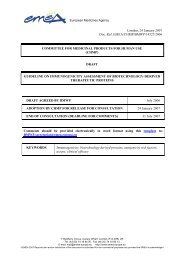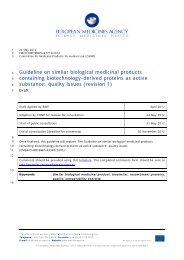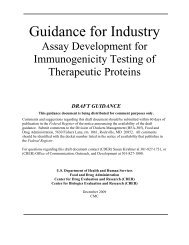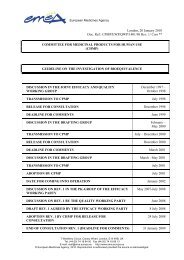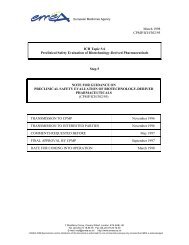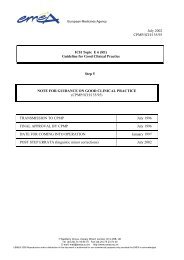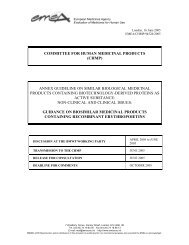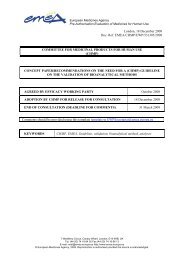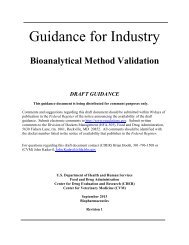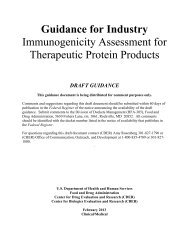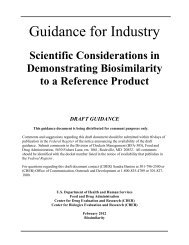Guidance for Industry - Assay Development
Assay Development for Immunogenicity Testing of Therapeutic Proteins, Draft Guidance http://www.ipm-biotech.de/fileadmin/user_upload/pdf/guidelines/FDA-GUIDANCE-Assay-Development-Immunogenicity-Testing.pdf
Assay Development for Immunogenicity Testing of Therapeutic Proteins, Draft Guidance
http://www.ipm-biotech.de/fileadmin/user_upload/pdf/guidelines/FDA-GUIDANCE-Assay-Development-Immunogenicity-Testing.pdf
Create successful ePaper yourself
Turn your PDF publications into a flip-book with our unique Google optimized e-Paper software.
649<br />
650<br />
651<br />
652<br />
653<br />
654<br />
655<br />
656<br />
657<br />
658<br />
659<br />
660<br />
661<br />
662<br />
663<br />
664<br />
665<br />
666<br />
667<br />
668<br />
669<br />
670<br />
671<br />
672<br />
673<br />
674<br />
675<br />
676<br />
677<br />
678<br />
679<br />
680<br />
681<br />
682<br />
683<br />
684<br />
685<br />
686<br />
687<br />
688<br />
689<br />
690<br />
691<br />
692<br />
693<br />
694<br />
Contains Nonbinding Recommendations<br />
Draft — Not <strong>for</strong> Implementation<br />
product’s half-life to help determine appropriate times <strong>for</strong> sampling. This is especially important<br />
<strong>for</strong> monoclonal antibody products because these products can have half-lives of several weeks or<br />
more and, depending on the dosing regimen, the therapeutic monoclonal antibody itself could<br />
remain present in the serum <strong>for</strong> months.<br />
The level of product that interferes with the assay, as determined by immune competition, may<br />
also help define meaningful time points <strong>for</strong> sampling. If drug-free samples cannot be obtained<br />
during the treatment phase or the trial, then the applicant should take additional samples after an<br />
appropriate washout period (e.g., five drug half-lives). Obtaining samples to test <strong>for</strong> meaningful<br />
antibody results can also be complicated if the product in question is itself an immune<br />
suppressant. In such instances, the applicant should obtain samples from patients who have<br />
undergone a washout period either because the treatment phase has ended or because the patient<br />
has dropped out of the study.<br />
B. Concurrent Positive and Negative Quality Controls<br />
If the applicant completes the proper validation work and makes the cut point determinations, the<br />
immunogenicity status of patients should be straight<strong>for</strong>ward to determine. However, FDA<br />
believes positive control or QC samples are critical and should be run concurrently with patient<br />
samples. We recommend that these samples span a level of positivity with QC samples having a<br />
known negative, low, medium, and high reactivity in the assay. More importantly, the samples<br />
should be diluted in the matrix in which patient samples will be examined (e.g., same percent<br />
serum/plasma). In this way, the applicant ensures that the assay is per<strong>for</strong>ming to its required<br />
degree of accuracy and that patient samples are correctly evaluated. For the low positive sample,<br />
we recommend that a concentration be selected that, upon statistical analysis, would lead to the<br />
rejection of an assay run 1 percent of the time. Such an approach would ensure the appropriate<br />
sensitivity of the assay when per<strong>for</strong>med on actual patient samples.<br />
FDA also recommends that these QC samples be obtained from humans or animals possessing<br />
antibodies that are detected by the secondary detecting reagent, to ensure that negative results<br />
that might be observed are truly due to lack of antigen reactivity and not due to failure of the<br />
secondary reagent. This issue is not a problem <strong>for</strong> antigen bridging studies (as labeled antigen is<br />
used <strong>for</strong> detection), although other considerations may apply in these assays.<br />
C. Cut Point Normalization<br />
FDA appreciates that there will be some degree of variability in an assay. Consequently, FDA<br />
recommends the applicant develop a predetermined method <strong>for</strong> normalization of data obtained at<br />
different times. During assay validation, the applicant should identify a negative or low QC<br />
sample and determine a normalization factor. The normalization factor is the difference in the<br />
readout value of the control and the value of the 95 percent limit obtained <strong>for</strong> the initial cut point<br />
determinations. The normalization factor can be added to the value obtained <strong>for</strong> the negative QC<br />
sample to normalize <strong>for</strong> the cut point of the assay per<strong>for</strong>med at different times. Other<br />
approaches may also be appropriate such as normalizing all values against those obtained with a<br />
negative control sample or in extreme cases establishing plate specific cut points.<br />
C:\8495dft.doc<br />
11/4/09<br />
16




